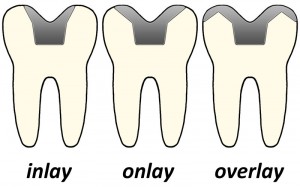 Dental inlays and onlays are restorative procedures that work well for patients who have teeth with cracked, fractured or mildly decayed teeth who do not require a full crown. Inlays and onlays are typically used to repair teeth in the back of the mouth that require more than a restorative filling. By using an inlay or onlay, your dentist can help preserve more of the natural structure of your tooth.
Dental inlays and onlays are restorative procedures that work well for patients who have teeth with cracked, fractured or mildly decayed teeth who do not require a full crown. Inlays and onlays are typically used to repair teeth in the back of the mouth that require more than a restorative filling. By using an inlay or onlay, your dentist can help preserve more of the natural structure of your tooth.
Dental inlays and onlays are similar to fillings and are often used to restore teeth with old or worn fillings. The inlay fits in-between the cusps of the tooth, while an onlay extends over the cusps, adding more extensive protection to the tooth than a filling would. Before applying a dental inlay or onlay, your dentist will remove your old fillings and take an impression of the affected tooth. Your inlay or onlay is then created in a lab using the impression. Once your dentist receives the inlay or onlay back, he will place it in your mouth using a special cement adhesive. Because of this process, your dental inlays and onlays treatment will take two visits to complete. Your dentist will, however, give you a temporary filling to protect your teeth until your treatment is completed.
The Advantages of Dental Inlays and Onlays
Dental inlays and onlays are made from gold, porcelain or composite resin (the same material that is used for tooth-colored fillings). Not only do inlays and onlays mock the color and appearance of your natural teeth, but they also improve your teeth’s strength and durability. In fact, your inlays and onlays can last up to 30 years and can strengthen your teeth by up to 75 percent.
Your dental inlays and onlays also give your teeth added protection against cracking, breaking and general decay. Because of this, your inlays and onlays can be an invaluable investment, as they can help improve the appearance of your smile while preventing the need for further restorative work down the road.